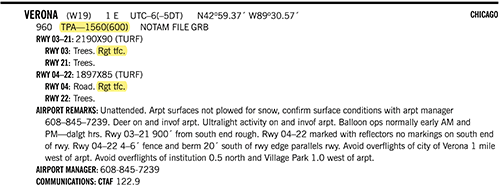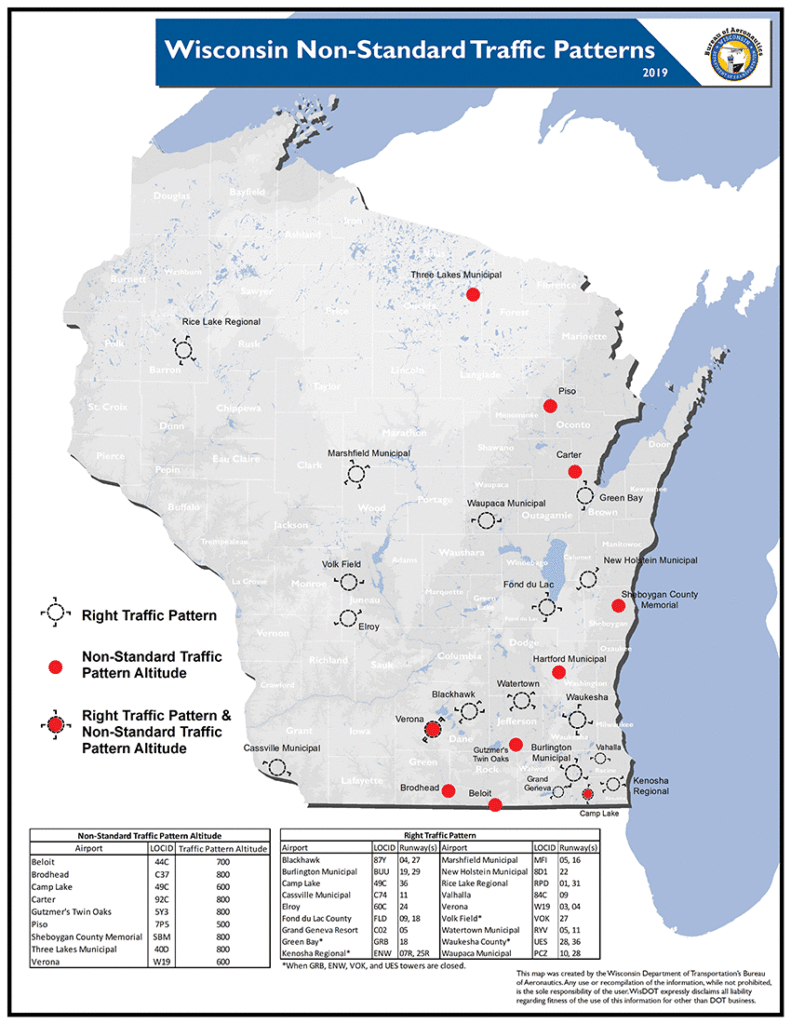by Hal Davis
WisDOT Bureau of Aeronautics
Published in Midwest Flyer – August/September 2019 issue
The fundamentals of the standard traffic pattern are something every pilot learns early on in their flight training. Just as roads provide a safe and efficient path for ground transportation, airport traffic patterns are necessary to facilitate the safe and orderly flow of air traffic at an airport, especially at an airport without an air traffic control tower.
The standard traffic pattern for a runway involves flying a rectangular pattern utilizing left turns at 1,000 feet above ground level (AGL). Use of this standard airport traffic pattern has several advantages, all of which improve safety.
First and foremost, a standard traffic pattern reduces the likelihood of midair collisions. Although pilots should never assume the airspace around them is clear, a standard traffic pattern allows pilots to better locate other aircraft and anticipate their movements around an airport. Aircraft entering the pattern are expected to observe the aircraft already in the pattern and merge with the existing flow of traffic. In addition, consistently flying the standard traffic pattern will help pilots develop the piloting skills and habits necessary to achieve consistently stable and safe approaches.
However, not all airports and runways utilize this standard traffic pattern for a variety of reasons. In some cases, a particular runway might utilize right turns rather than left turns. This could be done to deconflict with the traffic patterns of other runways or to minimize overflight of sensitive areas.
Other airports may use a nonstandard traffic pattern altitude, typically one that is lower than 1,000 feet AGL. This might be done to avoid overlying airspace or may reflect the operating characteristics of common users of the airport, such as gliders and ultralights. In the end, it is up to the airport to determine the traffic pattern altitude and direction of traffic, though all airports are encouraged to use the standard traffic pattern whenever possible.
Know before you go
Before flying to an unfamiliar airport, it’s important to find out if the standard traffic pattern is used. The best resource for this information is the chart supplement. Nonstandard traffic pattern altitude, abbreviated as TPA, will be listed near the top of each airport listing. If no TPA is listed, you can assume the traffic pattern altitude is 1,000 feet AGL. In some cases, the TPA will reference the remarks section of the airport listing, in which additional information about traffic pattern altitudes will be provided. For instance, some airports will publish special traffic pattern altitudes for certain types of aircraft, such as gliders. Right information is in the runways section of the airport listing.
In addition, the Wisconsin Bureau of Aeronautics has recently published a new map identifying airports with nonstandard traffic patterns as a resource when planning flights in Wisconsin. The map is shown on page 51 in this issue, and is also available for download at: https://wisconsindot.gov/av-pubs.
It’s always recommended that pilots overfly the airport prior to entering the traffic pattern. By overflying the airport, pilots have an opportunity to better observe the windsock and other traffic in the pattern. Some airports will also utilize segmented circles on the ground to notify pilots of traffic patterns with right turns.
While flying the published traffic pattern is highly recommended, it is not legally required. Some aircraft will require a higher, lower, larger or smaller traffic pattern than a single-engine, fixed-wing aircraft. Pilots should always remain vigilant for other air traffic. Surprisingly, accident statistics indicate most midair collisions occur during daylight hours, under good visibility, and in close proximity to an airport.
For more information about traffic patterns, see the Federal Aviation Administration Advisory Circular 90-66B Non-Towered Airport Flight Operations.

